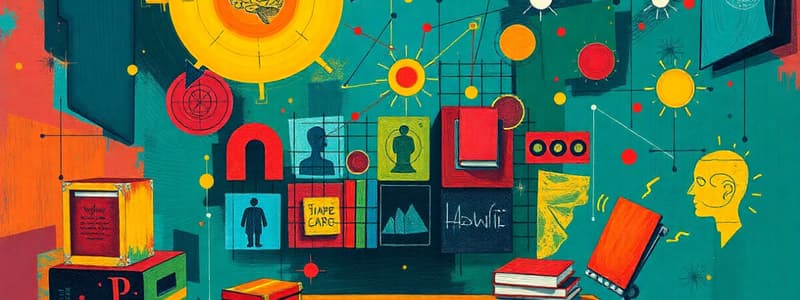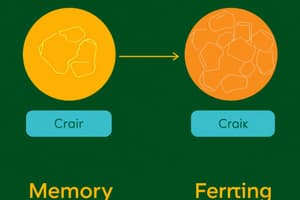Podcast
Questions and Answers
What is a recommended strategy for enhancing recall during an exam?
What is a recommended strategy for enhancing recall during an exam?
- Visualizing abstract concepts
- Writing notes during the exam
- Studying with a group of friends
- Using the exam room as a memory palace (correct)
What does the term 'context-dependent memory' refer to?
What does the term 'context-dependent memory' refer to?
- Using mnemonic devices to enhance memory
- Remembering information better when in the same environment as learned (correct)
- Learning through repetition in different environments
- Recalling information in a specific emotional state
Which alternative memory strategy was mentioned if the exam room cannot be used as a memory palace?
Which alternative memory strategy was mentioned if the exam room cannot be used as a memory palace?
- Using library resources
- Reading textbooks in a quiet place
- Employing the surrounding campus area as a memory palace (correct)
- Utilizing online study forums
What overall approach does the 'magnetic memory method' advocate?
What overall approach does the 'magnetic memory method' advocate?
Which key benefit is associated with using a memory palace for exam preparation?
Which key benefit is associated with using a memory palace for exam preparation?
What does the phrase 'sharpen that axe' imply in the context of studying?
What does the phrase 'sharpen that axe' imply in the context of studying?
What is the significance of combining different mnemonics according to the discussed approach?
What is the significance of combining different mnemonics according to the discussed approach?
What is recommended for better preparation when using the magnetic memory method?
What is recommended for better preparation when using the magnetic memory method?
What is the main purpose of the Memory Palace technique?
What is the main purpose of the Memory Palace technique?
Which historical figure is mentioned as one of the earliest users of the Memory Palace technique?
Which historical figure is mentioned as one of the earliest users of the Memory Palace technique?
What should you consider when creating a Memory Palace?
What should you consider when creating a Memory Palace?
How is the 'romantic effect' described in relation to memorization?
How is the 'romantic effect' described in relation to memorization?
What is recommended to avoid unnecessary cognitive load in a Memory Palace?
What is recommended to avoid unnecessary cognitive load in a Memory Palace?
Why is reducing the number of items to memorize beneficial?
Why is reducing the number of items to memorize beneficial?
What aspect of memory interests the speaker most regarding studying techniques?
What aspect of memory interests the speaker most regarding studying techniques?
What technique does the speaker suggest using together with the Memory Palace?
What technique does the speaker suggest using together with the Memory Palace?
What is the suggested approach to using book pages as mini Memory Palaces?
What is the suggested approach to using book pages as mini Memory Palaces?
What is the implication of combining memory systems with the Memory Palace technique?
What is the implication of combining memory systems with the Memory Palace technique?
Which of the following is NOT a recommended practice when using Memory Palaces?
Which of the following is NOT a recommended practice when using Memory Palaces?
What is advised against when first starting to use the Memory Palace technique?
What is advised against when first starting to use the Memory Palace technique?
What is essential for effective recall rehearsal within a Memory Palace?
What is essential for effective recall rehearsal within a Memory Palace?
How can memory scientists' concept of elaborative encoding improve Memory Palace usage?
How can memory scientists' concept of elaborative encoding improve Memory Palace usage?
Flashcards
Context-Dependent Memory
Context-Dependent Memory
When you remember information better in the same environment where you learned it.
State-Dependent Memory
State-Dependent Memory
When you remember information better in the same mental state where you learned it.
Memory Palace
Memory Palace
Using a physical space as a framework to organize and store information.
Exam Memory Palace
Exam Memory Palace
Signup and view all the flashcards
Campus Memory Palace
Campus Memory Palace
Signup and view all the flashcards
Mnemonic Systems
Mnemonic Systems
Signup and view all the flashcards
Fundamentals of Memory Enhancement
Fundamentals of Memory Enhancement
Signup and view all the flashcards
Effortless Recall with Mnemonic Systems
Effortless Recall with Mnemonic Systems
Signup and view all the flashcards
What are the five techniques that make up the Memory Palace technique?
What are the five techniques that make up the Memory Palace technique?
Signup and view all the flashcards
What is the overall benefit of using the Memory Palace technique correctly?
What is the overall benefit of using the Memory Palace technique correctly?
Signup and view all the flashcards
What makes a memory palace "true"?
What makes a memory palace "true"?
Signup and view all the flashcards
How do you select the right information to memorize using the Memory Palace technique?
How do you select the right information to memorize using the Memory Palace technique?
Signup and view all the flashcards
What is the "romatic effect"?
What is the "romatic effect"?
Signup and view all the flashcards
How can you use a book itself as a Memory Palace?
How can you use a book itself as a Memory Palace?
Signup and view all the flashcards
What is elaborative encoding and how does it work with the Memory Palace technique?
What is elaborative encoding and how does it work with the Memory Palace technique?
Signup and view all the flashcards
What is the "cave cogs" formula?
What is the "cave cogs" formula?
Signup and view all the flashcards
How can you organize Memory Palaces for multiple subjects?
How can you organize Memory Palaces for multiple subjects?
Signup and view all the flashcards
What is the major (or Pao) system?
What is the major (or Pao) system?
Signup and view all the flashcards
What is recall rehearsal and why is it important?
What is recall rehearsal and why is it important?
Signup and view all the flashcards
What is compounding in the Memory Palace technique?
What is compounding in the Memory Palace technique?
Signup and view all the flashcards
What is the principle of context dependence, or state-dependent memory?
What is the principle of context dependence, or state-dependent memory?
Signup and view all the flashcards
Why is it important to commit to a specific Memory Palace method for an extended time?
Why is it important to commit to a specific Memory Palace method for an extended time?
Signup and view all the flashcards
How can you train your mind for automatic associations?
How can you train your mind for automatic associations?
Signup and view all the flashcards
How do you use the "cave cogs" formula to enhance memory?
How do you use the "cave cogs" formula to enhance memory?
Signup and view all the flashcards
Study Notes
Memory Palace Technique for Studying
- The Memory Palace technique, taught in its entirety, is a powerful study method. It involves placing information in long-term memory through active learning.
- Its origin is uncertain, but historical use is well understood. Educators have long emphasized particular methods of use, going beyond general ideas.
- Hugh of St. Victor used number systems to memorize historical dates (and numbers can encode any facts). He also reused Memory Palaces to layer information.
- The Memory Palace is not one technique, but five techniques combined: using locations, alphabetical associations, numerical associations, symbols, and space repetition.
- The Memory Palace technique is not about visualizing elaborate palaces; it's about using existing memories to create clear, logical associations in a journey that can be as simple or complex as needed.
- Avoiding unnecessary mental elaborations is crucial. Only include what is necessary to remember, whether it be the space or the objects within.
- Memory Palaces should be based on your existing memory. Don't invent details; use familiar locations.
- Linearity of the Memory Journey ensures easy recall. Start at one location and move linearly throughout the mental palace.
Optimizing the Technique for Studying
- Limit your memorization to key points. Gather information; then assess and filter what to memorize.
- "Romatic effect" refers to the technique of culling information to focus on the most essential elements — the 10 items, rather than 30.
- Using pages of a book as mini Memory Palaces is possible, but less efficient than dedicated Memory Palaces for exam situations. Number systems (like the major system) create clear distinctions for each page.
- The focus is on clear, distinctive locations. These should be non-fiddly; clear enough not to require extra thought.
- Elaborative encoding is crucial. Logic and multi-sensory associations are key. Think of the feeling, sound, emotion, size, concept, smell, and taste associated to make a full sensory association.
- Using pre-existing knowledge is essential: Use existing images from other contexts (people from your life, characters from TV shows) in your Memory Palace.
Expanding and Using the Method Effectively
- Create memory palaces for multiple subjects. An ideal system is one memory palace for each letter of the alphabet.
- Number-based memory palaces, layers of memory palaces, and building on existent ones (with building on pre-established context) are possible; simplicity is key.
- For exams, make use of the testing location and/or the campus surroundings as the Memory Palace when you can.
- Use recall rehearsal to establish long-term memory. Move throughout the palace forwards and backwards, revisiting stations in varied orders (revisit middle, end, beginning). Mistakes are an opportunity to adjust images.
- Mastering the fundamentals (locations, associations, recall) reduces the possibility of cluttered memory palaces.
Cave Cogs Formula (for Elaborative Encoding)
- For deep memorization, employ a multi-sensory method called "cave cogs" that includes kinesthetic, auditory, visual, emotional, conceptual, olfactory, gustatory, and spatial elements.
- Use what you already know (like a character from a movie) and build complex, multi-sensory links with the subject's details.
Studying That Suits You
Use AI to generate personalized quizzes and flashcards to suit your learning preferences.




